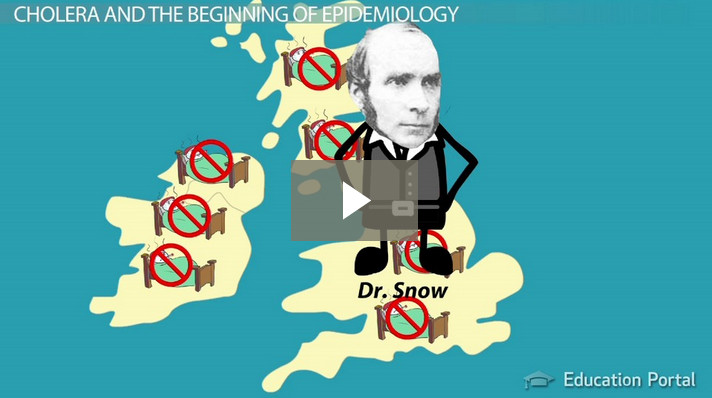What Is Cholera? - Disease Symptoms and Vibrio Cholerae
 |
film video internet Jan 2010 ; Durée: 8 min.
Ed. Education Portal - Mountain View
Téléchargeable chez l'éditeur
Abstract:
Cholera and the Beginning of Epidemiology
How do you stop a disease when you have no idea what's causing it? For hundreds, if not thousands of years, this question has plagued mankind. Today, when a new illness begins sweeping through a population, hundreds of doctors and scientists mobilize and examine everything they can get their hands on. Technology allows these officials to see even the tiniest organisms and find the smallest bit of DNA in an ocean of potential evidence.
But in London in 1854, Dr. John Snow didn't have electron microscopes, DNA sequencers or an army of experts. All he had was 500 Londoners dead in ten days from cholera, and a ton of questions needing answers. Dr. Snow pored over all the recent death records and interviewed people from the hardest hit neighborhood. He questioned people about where they had gone, what they had eaten, where they got their water and anything he could think of to try to find a pattern.
And quickly, one emerged. Everyone that had gotten sick, whether they died from cholera or recovered, had gotten water from the Broad Street well. People living near the well that didn't get sick had been getting their water from different sources. Dr. Snow convinced the local officials to remove the pump handle from the well to stop people from drinking the water. The outbreak immediately stopped.
Dr. Snow, by focusing on the entire population, not just on the individual person afflicted by cholera, conducted one of the first epidemiology studies. He helped usher in this new science and a new way of looking at disease outbreaks. Dr. Snow stopped the cholera outbreak and likely saved hundreds of lives, but it wasn't the end of cholera. This devastating disease is still killing people today.
Vibrio Cholerae
The organism that causes cholera is Vibrio cholerae, a motile, Gram-negative, curved, rod-shaped bacteria. Gram-negative refers to V. cholerae having a cell wall with a thin peptidoglycan layer and an outer membrane, making these cells appear red in the classic Gram stain. V. cholerae are normally found as free-living bacteria in coastal and brackish waters. It can also survive in the human intestine, making sewage a common source of infection. In fact, most people become infected with the bacteria by drinking water contaminated with infected human sewage.
Most cases of cholera occur in developing countries with inadequate sewage treatment. Cases in the United States are rare and almost always involve someone who recently traveled to a country where the disease is more common. There has been an increase in cases in the United States along the Gulf Coast, linked to consuming raw shellfish that were caught from a contaminated body of water.
Cholera Symptoms
Cholera is a bacterial disease caused by Vibrio cholerae and characterized by severe diarrhea. Despite the deadly reputation, most people exposed to the bacteria never get sick, or have only very mild symptoms. This is usually limited to watery diarrhea that goes away on its own.
About 5% of people will develop a very severe, life-threatening case of cholera. These cases usually involve a person who consumed a massive amount of V. cholerae cells. It takes between 100 million and a billion cells to produce symptoms. V. cholerae is sensitive to the stomach acid, so these high numbers are required to ensure some cells survive passage through the stomach to colonize the small intestine. Taking antacids or eating large meals can protect the bacteria from the stomach acid, resulting in disease with fewer consumed cells.
Once in the small intestine, the bacteria begin releasing an enterotoxin, which is a toxin active in the gastrointestinal tract of a host. Symptoms associated with the enterotoxin appear in about two to three days. For the unlucky five percent, what results is severe, watery diarrhea; vomiting; rapid heart rate; muscle cramps; extreme thirst; and skin that appears dry, cold and wrinkled.
The skin symptoms are a result of the rapid and severe dehydration that results from the profuse diarrhea, up to one liter of fluid loss every hour. Rice water stools is the name given to cholera diarrhea due to its colorless, watery appearance, flecked with rice-like mucus.
If untreated, 60% of the people that develop a severe case of cholera will die. Death is a direct result of complications from dehydration. The extreme loss of water causes the body to stop producing urine and leads to very rapid kidney failure. Blood pressure plummets and heart rate increases in an attempt to get enough blood to the brain.
Eventually, the blood thickens to the point where it can't effectively fuel the body or the brain and the patient goes into shock. Death usually follows quickly. It is not uncommon for a person to start experiencing symptoms in the morning and be shriveled, dehydrated and dead that same day.
Editeur/Diffuseur: |
|
Education Portal - Mountain View - Etats Unis |
En cas de lien brisé, nous le mentionner à communication@pseau.org